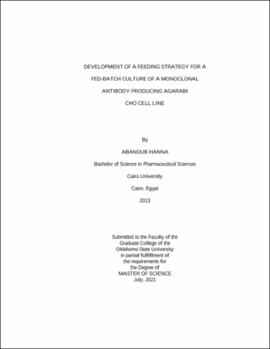| dc.contributor.advisor | Ramsey, Joshua D. | |
| dc.contributor.author | Hanna, Abanoub | |
| dc.date.accessioned | 2022-01-21T19:33:44Z | |
| dc.date.available | 2022-01-21T19:33:44Z | |
| dc.date.issued | 2021-07 | |
| dc.identifier.uri | https://hdl.handle.net/11244/333803 | |
| dc.description.abstract | Animal cell culture is the most extensively used platform for producing novel, recombinant DNA-based therapeutics as these cells have the required machinery to make human-like post-translational modifications. In 2017, therapeutic antibodies became the main product produced by the biopharmaceutical industry, with antibodies making up approximately 20% of the entire global pharmaceutical market. Mammalian cells, such as baby hamster kidney cells, human embryonic kidney cells, and mouse myeloma cells, are common choices for hosts to produce complex recombinant therapeutic proteins. Chinese Hamster Ovary (CHO) cells, however, are considered the gold standard when it comes to large-scale manufacturing processes. Currently, fed-batch culture is the preferred operation mode to produce monoclonal antibodies (mAbs) in mammalian cells. An ideal feeding regimen prevents the depletion of critical medium components and maximizes final product concentration, which depends on the viable cell concentration and the specific production rate of that cell line. The main objective of this work was to develop a feeding strategy for a fed-batch culture with SFM4CHO basal medium growing chimeric IgG1-producing cells, Agarabi CHO. One of our goals of the strategy was to maintain the glucose and glutamine levels within a specified range while adding Cell Boost 7a/7b at fixed times with different volumetric ratios to the cell culture basal medium. Operating as fed-batch and adding Cell Boost 7a containing glucose to the SFM4CHO basal medium led to an increase in the accumulation of glucose and by-products, especially in the early stage of the culture. The replacement of the feed supplement with Cell Boost 7a lacking glucose and substituting the L-glutamine with dipeptide glutamine led to reduce accumulation of glucose and by-products, especially ammonia and lactate. Our feeding strategy developed for a fed-batch culture led to a 4-fold increase in the maximum cell density and increased the longevity of the culture by more than 2-fold compared to batch culture conditions. | |
| dc.format | application/pdf | |
| dc.language | en_US | |
| dc.rights | Copyright is held by the author who has granted the Oklahoma State University Library the non-exclusive right to share this material in its institutional repository. Contact Digital Library Services at lib-dls@okstate.edu or 405-744-9161 for the permission policy on the use, reproduction or distribution of this material. | |
| dc.title | Development of a feeding strategy for a fed-batch culture of a monoclonal antibody-producing Agarabi CHO cell line | |
| dc.contributor.committeeMember | Fahlenkamp, Heather | |
| dc.contributor.committeeMember | Hemmati, Shohreh | |
| osu.filename | Hanna_okstate_0664M_17312.pdf | |
| osu.accesstype | Open Access | |
| dc.type.genre | Thesis | |
| dc.type.material | Text | |
| dc.subject.keywords | cell boost 7a without glucose | |
| dc.subject.keywords | cell boost 7a/7b | |
| dc.subject.keywords | cho | |
| dc.subject.keywords | fed-batch culture development | |
| dc.subject.keywords | mammalian cell culture | |
| dc.subject.keywords | sfm4cho medium | |
| thesis.degree.discipline | Chemical Engineering | |
| thesis.degree.grantor | Oklahoma State University | |
